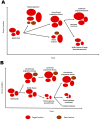Trial Design for Cancer Immunotherapy: A Methodological Toolkit
- PMID: 37760636
- PMCID: PMC10527464
- DOI: 10.3390/cancers15184669
Trial Design for Cancer Immunotherapy: A Methodological Toolkit
Abstract
Immunotherapy with checkpoint inhibitors (CPIs) and cell-based products has revolutionized the treatment of various solid tumors and hematologic malignancies. These agents have shown unprecedented response rates and long-term benefits in various settings. These clinical advances have also pointed to the need for new or adapted approaches to trial design and assessment of efficacy and safety, both in the early and late phases of drug development. Some of the conventional statistical methods and endpoints used in other areas of oncology appear to be less appropriate in immuno-oncology. Conversely, other methods and endpoints have emerged as alternatives. In this article, we discuss issues related to trial design in the early and late phases of drug development in immuno-oncology, with a focus on CPIs. For early trials, we review the most salient issues related to dose escalation, use and limitations of tumor response and progression criteria for immunotherapy, the role of duration of response as an endpoint in and of itself, and the need to conduct randomized trials as early as possible in the development of new therapies. For late phases, we discuss the choice of primary endpoints for randomized trials, review the current status of surrogate endpoints, and discuss specific statistical issues related to immunotherapy, including non-proportional hazards in the assessment of time-to-event endpoints, alternatives to the Cox model in these settings, and the method of generalized pairwise comparisons, which can provide a patient-centric assessment of clinical benefit and be used to design randomized trials.
Keywords: checkpoint inhibitors; immunotherapy; trial design.
Conflict of interest statement
The authors declare no conflict of interest.
Figures
Similar articles
-
Some statistical considerations in the clinical development of cancer immunotherapies.Pharm Stat. 2018 Feb;17(1):49-60. doi: 10.1002/pst.1835. Epub 2017 Nov 2. Pharm Stat. 2018. PMID: 29098766 Review.
-
The changing face of clinical trials in the personalized medicine and immuno-oncology era: report from the international congress on clinical trials in Oncology & Hemato-Oncology (ICTO 2017).J Exp Clin Cancer Res. 2017 Dec 28;36(1):192. doi: 10.1186/s13046-017-0668-0. J Exp Clin Cancer Res. 2017. PMID: 29282151 Free PMC article.
-
Role of Checkpoint Inhibitors in the Management of Gastroesophageal Cancers.Cancers (Basel). 2023 Aug 14;15(16):4099. doi: 10.3390/cancers15164099. Cancers (Basel). 2023. PMID: 37627127 Free PMC article. Review.
-
Immunotherapy with check-point inhibitors (CPI) in adult malignancies: a protocol for the systematic review of the quality of economic analyses.Syst Rev. 2019 Jun 11;8(1):139. doi: 10.1186/s13643-019-1047-z. Syst Rev. 2019. PMID: 31186068 Free PMC article.
-
The future of Cochrane Neonatal.Early Hum Dev. 2020 Nov;150:105191. doi: 10.1016/j.earlhumdev.2020.105191. Epub 2020 Sep 12. Early Hum Dev. 2020. PMID: 33036834
Cited by
-
Integrative multi-omics analysis uncovers tumor-immune-gut axis influencing immunotherapy outcomes in ovarian cancer.Nat Commun. 2024 Dec 5;15(1):10609. doi: 10.1038/s41467-024-54565-8. Nat Commun. 2024. PMID: 39638782 Free PMC article. Clinical Trial.
-
Estimation of the Restricted Mean Duration of Response (RMDoR) in Oncology.Pharm Stat. 2025 Jan-Feb;24(1):e2468. doi: 10.1002/pst.2468. Pharm Stat. 2025. PMID: 39916591 Free PMC article.
-
The Win Ratio Approach in Bayesian Monitoring for Two-Arm Phase II Clinical Trial Designs With Multiple Time-To-Event Endpoints.Stat Med. 2024 Dec 30;43(30):5922-5934. doi: 10.1002/sim.10282. Epub 2024 Nov 25. Stat Med. 2024. PMID: 39582325
References
Publication types
LinkOut - more resources
Full Text Sources


